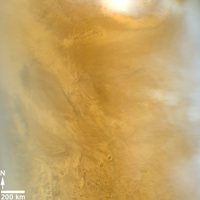
Figure 1
Click on the image for larger versionThis image from the Mars Color Imager (MARCI) camera on NASA's Mars Reconnaissance Orbiter has a dark spot (at center of inscribed rectangle) noticed while the image was being examined for a weekly Mars weather report. This wide-angle camera provides daily global coverage of Mars for monitoring dust storms and other changes in weather. The image was taken March 20, 2014. Other observations confirmed that the dark spot is a scar from a space rock hitting Mars.
Detection of the dark spot in this image triggered a check of earlier MARCI images. The spot resembles fresh impact scars seen with other cameras. The check of earlier MARCI images confirmed that this spot resulted from an event that occurred in the interval between images taken during Martian afternoons on March 27, 2012, and March 28, 2012 (see https://photojournal.jpl.nasa.gov/catalog/PIA18381). Mars orbiters have located about 400 fresh impacts on Mars that have been confirmed with before-and-after images. This is the only one to be detected in a MARCI image. MARCI's daily global imaging enabled determining the impact timing more precisely than in any other case.
This image covers an area about 1,000 miles (1,600 kilometers) wide. The dark spot confirmed to be an impact scar is about 5 miles (8 kilometers) across, at 3 degrees north latitude, 219 degrees east longitude.
Figure 1 is version of the same image without the inscribed rectangle.
Follow-up observations with two telescopic cameras on Mars Reconnaissance Orbiter revealed craters within this impact scar that had not been present in January 2012. The largest of these craters -- 159 feet (48.5 meters) wide -- is the biggest fresh impact crater ever clearly confirmed anywhere with before-and-after images.
MARCI is one of six instruments on NASA's Mars Reconnaissance Orbiter. The camera was built by and is operated by Malin Space Science Systems, San Diego. NASA's Jet Propulsion Laboratory, a division of the California Institute of Technology in Pasadena, manages the Mars Reconnaissance Orbiter Project for NASA's Science Mission Directorate, Washington.

